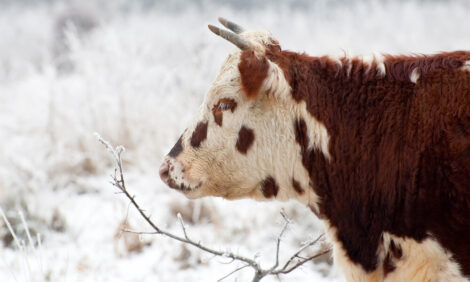



Identification and Disease Management Go Hand In Hand
CANADA - Trading beef is a complex pattern of pathways. As producers seek an unencumbered market environment that allows buyers from around the world to bid on their calves, a struggle has ensued, writes Kris Ringwall.Producers want to maximize business options and maintain the flexibility to market their stock. There is a need to utilize methods that capture value for the producer and enhance value to all links in the beef industry.
The big challenge is the calf and all that goes with the calf. The calf has the potential to carry any disease that it has been exposed to and potentially spread the disease to susceptible calves.
This is not a big deal with a strain of the common cold, but certainly is not true for all diseases. That is why animal identification and disease management are closely linked and work together.
Through individual identification efforts, producers know traceback, a function of health, sanitary and food safety, is critical to fully maintain effective health regulations. It also is important to limit new animal health risks, even if import restrictions are misconstrued as trade barriers. The tracking of animals that cross borders is considered essential for the well-being of the industry.
The introduction of a highly pathogenic disease, such as foot and mouth disease, would affect millions of animals and have a devastating effect on our markets and producers. One only needs to recall the pits filled with burning livestock carcasses in the United Kingdom outbreak to understand how rapid identification and containment of infected stock is crucial to minimizing such a disease outbreak.
In addition to potential disasters, we face other significant disease challenges. Examples include Johne’s disease (Mycobacterium paratuberculosis), which is a chronic, untreatable disease affecting cattle, or anthrax (Bacillus anthracis), which is a disease that indefinitely infects a premises and threatens livestock for decades. Bovine Spongiform Encephalopathy (mad cow disease) is transmittable through feed and may take years to develop clinical signs. Cases must be traced back to the herd of origin to investigate the source.
Mandatory electronic animal identification programs have been instituted in efforts to assist in containing bovine tuberculosis and brucellosis, both zoonotic diseases with livestock–human– wildlife interfaces. Producers and consumers know that these animal and public health concerns will not be tolerated.
The industry, by way of producers, well-qualified veterinary professionals and impeccable industry standards, will be vigilant and are preparing diligently for strong intervention and response should the need arise. However, preventing devastating socio-economic diseases must remain our country’s paramount priority.
No group, country, producer, company or cooperative should have cattle or products that claim to be more wholesome and safe than the competition. Regulatory standards need to be high enough to prevent any question as to the wholesomeness and safety of the food we consume.
Regulatory standards may be “barriers” for some or “reasonable import restrictions” for others. In the process, the science on some issues, when unclear and not fully agreed upon by all stakeholders, becomes a factor in setting minimal food safety standards.
Whatever the issue, the national herd always must be protected from health risks. Demand for and marketability of our nation’s animals and products then easily follows.
The beef industry needs a modern, effective system of individual accountability. The system should be respectful of local concerns, realistic in response to pathogenic challenges and responsive to industry needs and consumer desires for animals and people.
Among the never-ending confusion, positioning and jostling, we only can hope some light will come to the podium. And given guidance, our producers are up to any challenge.
TheCattleSite News Desk


